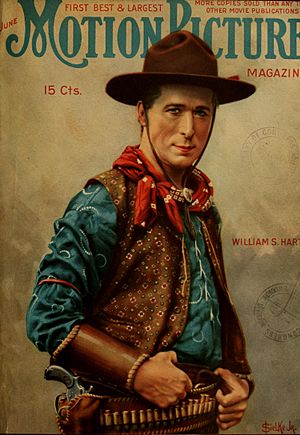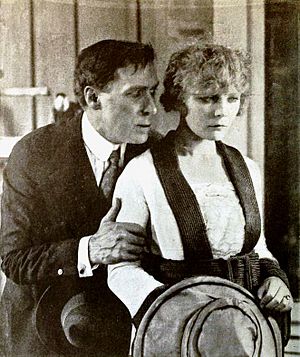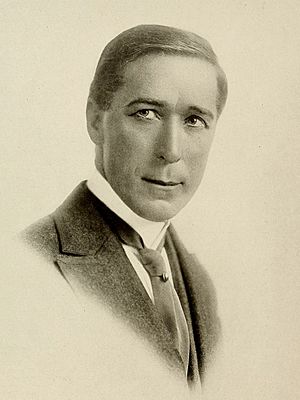William S. Hart facts for kids
Quick facts for kids
William S. Hart
|
|
|---|---|
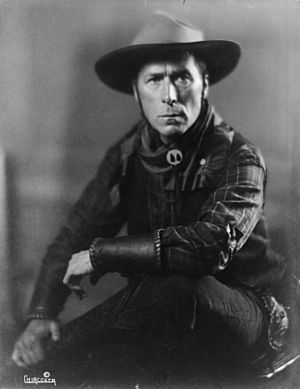
Hart, c. 1918
|
|
| Born |
William Surrey Hart
December 6, 1864 Newburgh, New York, U.S.
|
| Died | June 23, 1946 (aged 81) Newhall, California, U.S.
|
| Occupation |
|
| Years active | 1888–1941 |
| Spouse(s) |
Winifred Westover
(m. 1921; div. 1927) |
| Children | 1 |
William Surrey Hart (December 6, 1864 – June 23, 1946) was an American actor, screenwriter, director, and producer. He became famous as a leading star in silent films, especially Westerns. People remembered him for playing characters who were always honorable and honest. In the late 1910s and early 1920s, he was one of the most popular movie stars.
Contents
Early Life and Stage Acting
William Hart was born in Newburgh, New York. His father was from England and his mother was from Ireland. He had four sisters, but his two brothers died very young.
William started acting on stage when he was in his 20s. His first performance was in 1888. He traveled a lot with different acting groups, trying to become a well-known actor. For a while, around 1900, he even directed shows at the Asheville Opera House in North Carolina. He was successful as a Shakespearean actor on Broadway. He appeared in the original 1899 play Ben-Hur.
Becoming a Western Movie Star
William S. Hart became one of the first big stars of Western movies. He loved the Old West and even owned Billy the Kid's "six shooters." He was friends with famous lawmen like Wyatt Earp and Bat Masterson.
Hart started making films in 1914. After a few small roles, he became a star in the movie The Bargain that same year. He wanted to make Western films that felt real. His movies were known for their true-to-life costumes and props. His acting skills, which he learned from performing Shakespeare, made his films even better.
From 1915 onwards, Hart starred in his own series of short Western films. These were so popular that he soon started making longer feature films. Many of his early movies continued to be shown in theaters for years. In 1915 and 1916, people voted him the biggest money-making star in the United States.
In 1917, Hart joined Famous Players-Lasky, which later became Paramount Pictures. In his films, he often rode a brown and white pinto horse he named Fritz. Fritz was one of the first movie horses to become famous by his own name, like Trigger and Silver later on. During World War I, Hart changed Fritz's name to something more American to show his patriotism. He also gave speeches across the country to support the war effort.
By the early 1920s, the style of Westerns began to change. Hart's serious, rugged Westerns with simple costumes started to go out of style. Audiences preferred new movie cowboys like Tom Mix, who wore flashier outfits and had more action scenes. Paramount Pictures stopped working with Hart.
Hart decided to make one last Western film his way. He used his own money to produce Tumbleweeds (1925). He released it through United Artists. The film was well-made, especially a big land-rush scene, but it didn't make much money. Hart felt United Artists didn't promote his film enough, so he sued them. The lawsuit lasted for many years, and Hart finally won in 1940.
After Tumbleweeds, Hart retired from making movies. He moved to his ranch home in Newhall, California. In 1939, he appeared in his only sound film. It was a short introduction for a re-release of Tumbleweeds. In this part, filmed at his ranch, 74-year-old Hart talked about the Old West and his silent movie days. This speech was his last appearance on screen.
Personal Life
William Hart was very close to his sister, Mary. When he moved to California, she came with him. He called Mary his "constant advisor" and said she helped him with fan mail. Mary was even a co-writer for two of his books.
In 1919, Hart worked with a young actress named Winifred Westover in the film John Petticoats. Hart later proposed to Winifred by mail, and she accepted.
On December 7, 1921, Hart married Winifred Westover in Los Angeles. She was 22, and he was 57. Winifred agreed to stop acting after their marriage.
Their son, William S. Hart, Jr., was born on September 22, 1922. The couple divorced in 1927. Winifred received money, and a trust fund was set up for their son's support and education. Their son lived with his mother and didn't spend much time with his father.
Death and Legacy
William S. Hart passed away on June 23, 1946, in Newhall, California, at the age of 81. He was buried in Green-Wood Cemetery in Brooklyn, New York.
For his important work in movies, William S. Hart has a star on the Hollywood Walk of Fame. In 1975, he was honored in the Western Performers Hall of Fame at the National Cowboy & Western Heritage Museum.
Hart's former home and ranch in Newhall, California, is now the William S. Hart Park. It is part of the Natural History Museum of Los Angeles County. The park and museum are free for everyone to visit. The William S. Hart High School District and William S. Hart Senior High School in Santa Clarita are also named after him.
A statue called "Range Rider of the Yellowstone," which Hart commissioned, stands in Billings, Montana. Hart gave it to the city in 1927.
Published Books
After he stopped making films, William S. Hart started writing stories and books. Some of his published books include:
- Pinto Ben and Other Stories (1919)
- The Golden West Boys, Injun and Whitey (1920)
- My Life East and West (1929)
Images for kids
William S. Hart Ranch and Museum
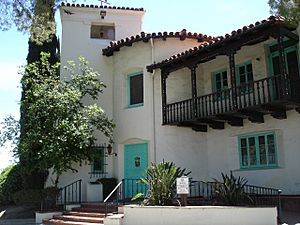
When William S. Hart died, he gave his home to Los Angeles County. He wanted it to become a park and museum for everyone. His former home in Newhall, Santa Clarita, California is now a part of the Natural History Museum of Los Angeles County. It is still free and open to the public.
The home is a beautiful Spanish Colonial Revival style mansion. It holds many of Hart's belongings, including Native American artifacts and art. Hart once said, "When I was making pictures, the people gave me their nickels, dimes, and quarters. When I am gone, I want them to have my home."
The park around the mansion is 265 acres. It has trails, an animal area with farm animals and bison, and a picnic area. The William S. Hart Park and Museum is located at 24151 Newhall Avenue, Santa Clarita, CA 91321. Since 2015, the park has hosted the Santa Clarita Cowboy Festival and the Annual Hart of the West Powwow.
See also
 In Spanish: William S. Hart para niños
In Spanish: William S. Hart para niños


